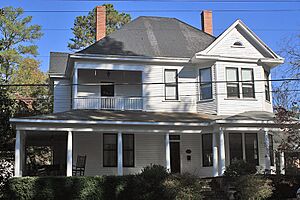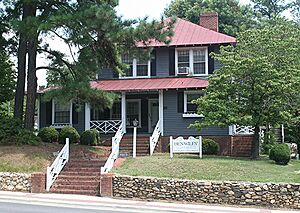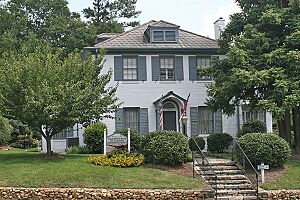Fuquay-Varina, North Carolina facts for kids
Quick facts for kids
Fuquay-Varina, North Carolina
|
|||
|---|---|---|---|
|
Town
|
|||
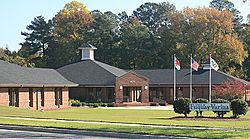
Fuquay-Varina Police Station
|
|||
|
|||
| Nickname(s):
Fuquay, The Quay
|
|||
| Motto(s):
"A Dash More"
|
|||
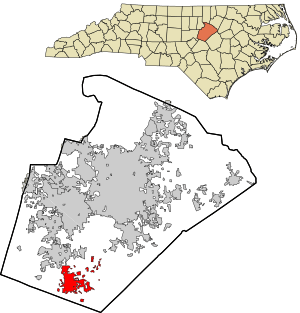
Location in Wake County and the state of North Carolina.
|
|||
| Country | United States | ||
| State | North Carolina | ||
| County | Wake | ||
| Incorporated | 1909 | ||
| Government | |||
| • Type | Council-Manager | ||
| Area | |||
| • Total | 18.73 sq mi (48.51 km2) | ||
| • Land | 18.65 sq mi (48.29 km2) | ||
| • Water | 0.08 sq mi (0.22 km2) | ||
| Elevation | 390 ft (120 m) | ||
| Population
(2020)
|
|||
| • Total | 34,152 | ||
| • Density | 1,831.60/sq mi (707.19/km2) | ||
| Time zone | UTC−5 (Eastern) | ||
| • Summer (DST) | UTC−4 (Eastern) | ||
| ZIP codes |
27526
|
||
| Area code(s) | 919/984 | ||
| FIPS code | 37-25300 | ||
| GNIS feature ID | 2406532 | ||
| Website | www.fuquay-varina.org | ||
Fuquay-Varina (pronounced FYOO-kway vuh-REE-nuh) is a town in southern Wake County, North Carolina. It's located south of Holly Springs and southwest of Garner. As of July 2021, about 36,736 people live there.
The town has a unique hyphenated name because it used to be two separate towns: Fuquay Springs and Varina. These two towns joined together in 1963 to form the modern town we know today. Fuquay-Varina first grew because of farming and the tobacco trade. More recently, it has seen a lot of new people and homes because it's close to Research Triangle Park, a major center for technology and research.
Contents
Geography and Climate
Fuquay-Varina is located in the central part of North Carolina. It sits where two major land regions meet: the Piedmont and the Atlantic Coastal Plain. This area is often called the "Fall Line." It's where rivers and creeks start to have waterfalls as the land changes elevation.
Being in the central Piedmont means Fuquay-Varina is about a three-hour drive west of Atlantic Beach and four hours east of the Great Smoky Mountains.
What is the climate like?
Fuquay-Varina has a mild climate. This means it has comfortable temperatures in spring, fall, and winter. Summers are usually hot and humid.
In winter, temperatures are often in the 30s to low 50s°F (around -2 to 13°C). Sometimes, it can even get warmer, reaching 60°F (15°C). Spring and fall days are usually pleasant, with temperatures in the low 70s°F (around 20s°C) during the day and cooler nights. Summer days often reach the upper 80s to low 90s°F (29 to 35°C). July is usually the month with the most rain.
History of Fuquay-Varina
How did Fuquay-Varina begin?
The town's story began with William Fuquay, a French settler, who came to a small farming area called Sippihaw. In 1858, his son, Stephen Fuquay, found a special spring while working on their tobacco farm. People soon believed the spring's mineral water had healing powers. This brought visitors from nearby areas. The spring was eventually walled in to help serve these visitors. In 1860, the Fuquay family sold the spring to a group who formed the Chalybeate Springs Company to promote it.
Around the same time, J. D. "Squire" Ballentine, a former schoolmaster, returned from the Civil War. He had received letters from a woman named Virginia Avery, who signed her letters "Varina." They later fell in love and married. When Ballentine became the first postmaster in 1880, he named the new post office "Varina" in her honor. A community grew around this post office and the Ballentines' general store. This area became known as Varina. In 1910, Ballentine built the Ballentine Spence House, which was the first house in the area to have plumbing and electricity. This historic house is still standing today.
Growth in the early 1900s
The Fuquay Mineral Spring became very popular in the 1890s. A local businessman, John Mills, started "Moonlight Excursions" by train from Raleigh to the springs. As more tourists arrived, small hotels, restaurants, and a dance pavilion appeared. The town became a fun place for holidays like Fourths of July and Easter. People from Raleigh would take the train to enjoy baseball games, dances, and celebrations. Hotels like the Ben Wiley Hotel (now the Fuquay Mineral Spring Inn & Garden) were central to town life.
In 1902, Sippihaw was renamed "Fuquay Springs" to honor the Fuquay family. It officially became a town in 1909. When Fuquay Springs was formed, it included parts of the neighboring town of Varina. But Varina soon rebuilt itself. A new train station, the Varina Union Station, was built, and a new post office opened. The Bank of Varina was also started, competing with the Bank of Fuquay.
Over the next few years, several warehouses for the growing tobacco business were built, using the railroad connections. The Fuquay Springs Corporation also began bottling and selling mineral water from the springs. In 1927, U.S. Route 401 was paved through town, making travel to Raleigh much faster.
How did the towns merge?
By the 1920s, both Fuquay Springs and Varina were important trading centers for the surrounding counties. However, as cars and roads improved, fewer people visited the springs for tourism. Instead, they traveled to the coast. The tobacco industry continued to be very important for the local economy.
Because both towns focused on farming and industry, and their residents lived and worked together, they decided to merge. In 1963, Fuquay Springs and Varina officially became one town: Fuquay-Varina.
Today, the town has many new homes and businesses. However, many old buildings from its past still stand. These include Victorian, Craftsman, and Colonial Revival homes. The Ben-Wiley Hotel, the Ballentine-Spence House, and the Dr. Wiley S. Cozart House are important historic landmarks. The original springs are now part of a small park, which the town maintains as a historic site.
The town has grown a lot. From 1970 to 2000, its population more than doubled. Between 2000 and 2010, it more than doubled again, reaching 17,937 people.
The current mayor of Fuquay-Varina is Blake Massengill. He was elected in 2021.
Education
Fuquay-Varina has several schools for its young residents. The town is served by seven public schools, which are managed by the Wake County Public School System. These include:
- Ballentine Elementary School
- Fuquay-Varina Elementary School
- Lincoln Heights Elementary School
- Herbert Akins Road Elementary
- Fuquay-Varina Middle School
- Fuquay-Varina High School
- South Lakes Elementary School
There is also Southern Wake Academy, which is a publicly funded charter school for grades 6 through 12. Hilltop Christian School is a private school in the town.
For higher education, the area is served by Wake Technical Community College, located between Fuquay-Varina and Raleigh.
Transportation
Roads in Fuquay-Varina
Three main roads run through Fuquay-Varina: two state routes and one U.S. route. All three use part of Main Street in the town's main business area, but then they go in different directions outside of downtown.
- NC 42 comes into town from the west. It then follows Academy Street. After meeting Main Street, NC 42 joins US 401 on North Main Street. Later, it splits off to the east towards Willow Springs.
- NC 55 enters the town from the northwest, coming from Holly Springs. It goes through the Varina Commercial Historic District. After meeting the other two routes, NC 55 also joins North Main Street. It then splits off to the south towards Angier.
- US 401 enters the town from the south. It is the main road through the Fuquay Springs Historic District, following South Main Street. After meeting NC 42 and NC 55, all three routes follow North Main Street. Then, US 401 heads northeast towards Garner.
Public transportation options
- Air travel: The nearest major airport is Raleigh-Durham International Airport, located in northwestern Wake County.
- Train travel: Fuquay-Varina does not have direct passenger train service. However, Amtrak trains serve nearby towns like Cary and Raleigh.
- Local bus: The Triangle Transit Authority runs buses that connect the region. These buses also link to the local bus systems in Raleigh, Durham, and Chapel Hill.
Parks and Recreation
Fuquay-Varina has many parks for people to enjoy:
- Fuquay Mineral Spring Park: This park is where the famous natural spring is located. It has picnic tables, a footbridge, a restored spring house, and a historical marker.
- South Park: This large park has two baseball fields, two soccer fields, and a multi-purpose area. It also has a community center, picnic shelters, playgrounds, a small water park for kids, and a walking track.
- Falcon Park: Here you'll find a youth baseball/softball field, a picnic shelter, a playground, and a gymnasium.
- Action Park: This park offers two youth softball/baseball fields, batting cages, a multi-purpose field, and four lighted tennis courts.
- Carroll Howard Johnson Environmental Education Park: This park has nature trails and free teaching kits for students from kindergarten to 12th grade. It also has an outdoor classroom and picnic areas.
- Ballentine School Park: This park has three youth baseball/softball fields and one multi-purpose field.
- Library Park: You can find a picnic shelter and a playground area here.
- Honeycutt Road Park: This park features two lighted soccer fields, two tennis courts, a playground, and a walking track.
- Kinton Soccer Field: A youth soccer field.
- Ransdell Soccer Field: Another youth soccer field.
- Fleming Loop Soccer Complex: Several youth soccer fields.
- Lawrence Street Park: A soccer field.
- Herbert Akins Park: Three soccer fields, great for tournaments or picnics.
- Banks Road Park: Two soccer fields and a baseball/softball field.
- Splash Pad: A 6,000 square foot water play area with many water jets. It's free for residents who have a Splash Pad card.
Notable People
- Justin Dowell, an Olympian in BMX Freestyle for Paris 2024.
- Paris Benegas, an Olympian in BMX Freestyle for Paris 2024.
- Lynton Y. Ballentine, a North Carolina dairyman, farmer, and politician.
- Andre Bowden, a professional football player in the Arena Football League.
- Beverly Buchanan, an African-American artist known for her paintings, sculptures, and land art.
- Connor Donovan, a professional soccer player.
- Rhett and Link, popular Internet entertainers who host Good Mythical Morning.
- Katharine Stinson, an aeronautical engineer and the first female engineer for the Federal Aviation Administration.
Images for kids
See also
 In Spanish: Fuquay-Varina para niños
In Spanish: Fuquay-Varina para niños



